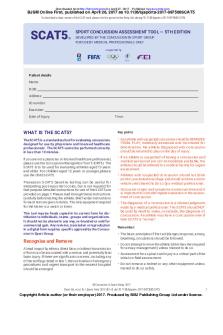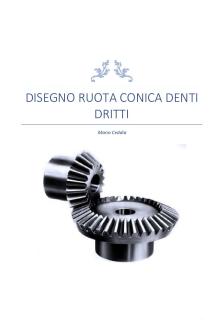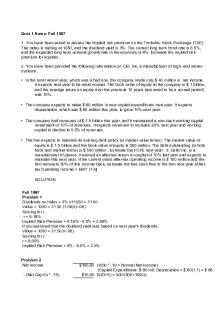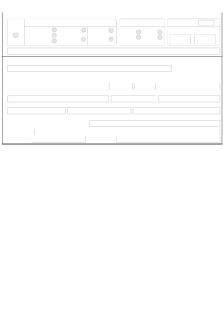Concussion - merged - PDF

| Title | Concussion - merged - |
|---|---|
| Author | Kira Gouchie |
| Course | Functional Assessment |
| Institution | Laurentian University |
| Pages | 23 |
| File Size | 1.3 MB |
| File Type | |
| Total Downloads | 86 |
| Total Views | 167 |
Summary
...
Description
Downloaded from http://bjsm.bmj.com/ on April 27, 2017 - Published by group.bmj.com
BJSM Online First, published on April 26, 2017 as 10.1136/bjsports-2017-097506SCAT5 To download a clean version of the SCAT tools please visit the journal online (http://dx.doi.org/10.1136/bjsports-2017-097506SCAT5)
SCAT5
©
SPORT CONCUSSION ASSESSMENT TOOL — 5TH EDITION DEVELOPED BY THE CONCUSSION IN SPORT GROUP FOR USE BY MEDICAL PROFESSIONALS ONLY supported by
Patient details Name: DOB: Address: ID number: Examiner: Date of Injury:
Time:
WHAT IS THE SCAT5?
Key points
The SCAT5 is a standardized tool for evaluating concussions designed for use by physicians and licensed healthcare professionals1. The SCAT5 cannot be performed correctly in less than 10 minutes.
• Any athlete with suspected concussion should be REMOVED FROM PLAY, medically assessed and monitored for deterioration. No athlete diagnosed with concussion should be returned to play on the day of injury.
If you are not a physician or licensed healthcare professional, please use the Concussion Recognition Tool 5 (CRT5). The SCAT5 is to be used for evaluating athletes aged 13 years and older. For children aged 12 years or younger, please use the Child SCAT5. Preseason SCAT5 baseline testing can be useful for interpreting post-injury test scores, but is not required for that purpose.Detailed instructions for use of the SCAT5 are provided on page 7. Please read through these instructions carefully before testing the athlete. Brief verbal instructions for each test are given in italics. The only equipment required for the tester is a watch or timer. This tool may be freely copied in its current form for distribution to individuals, teams, groups and organizations. It should not be altered in any way, re-branded or sold for commercial gain. Any revision, translation or reproduction in a digital form requires specific approval by the Concussion in Sport Group.
Recognise and Remove A head impact by either a direct blow or indirect transmission of force can be associated with a serious and potentially fatal brain inury. f there are significant concerns, including any of the red flags listed in Box , then activation of emergency procedures and urgent transport to the nearest hospital should be arranged.
• If an athlete is suspected of having a concussion and medical personnel are not immediately available, the athlete should be referred to a medical facility for urgent assessment. • Athletes with suspected concussion should not drink alcohol, use recreational drugs and should not drive a motor vehicle until cleared to do so by a medical professional. • Concussion signs and symptoms evolve over time and it is important to consider repeat evaluation in the assessment of concussion. • The diagnosis of a concussion is a clinical judgment, made by a medical professional. The SCAT5 should NOT be used by itself to make, or exclude, the diagnosis of concussion. An athlete may have a concussion even if their SCAT5 is “normal”. Remember: • The basic principles of first aid danger, response, airway, breathing, circulation) should be followed. • Do not attempt to move the athlete (other than that required for airway management) unless trained to do so. • Assessment for a spinal cord injury is a critical part of the initial on-field assessment. • Do not remove a helmet or any other equipment unless trained to do so safely.
© Concussion in Sport Group 2017 Davis GA, et al. Br J Sports Med 2017;0:1–8. doi:10.1136/bjsports-2017-097506SCAT5
Copyright Article author (or their employer) 2017. Produced by BMJ Publishing Group Ltd under licence.
1
Downloaded from http://bjsm.bmj.com/ on April 27, 2017 - Published by group.bmj.com
1 Name: DOB:
IMMEDIATE OR ON-FIELD ASSESSMENT The following elements should be assessed for all athletes who are suspected of having a concussion prior to proceeding to the neurocognitive assessment and ideally should be done on-field after the first first aid / emergency care priorities are completed. If any of the “Red Flags“ or observable signs are noted after a direct or indirect blow to the head, the athlete should be immediately and safely removed from participation and evaluated by a physician or licensed healthcare professional. Consideration of transportation to a medical facility should be at the discretion of the physician or licensed healthcare professional. The GCS is important as a standard measure for all patients and can be done serially if necessary in the event of deterioration in conscious state. The Maddocks questions and cervical spine exam are critical steps of the immediate assessment; however, these do not need to be done serially.
STEP 1: RED FLAGS RED FLAGS: •
Neck pain or tenderness
•
Double vision
•
Weakness or tingling/ burning in arms or legs
•
Severe or increasing headache
ID number: Examiner: Date:
STEP 4: EXAMINATION GLASGOW COMA SCALE (GCS)3 Time of assessment Date of assessment
Best eye response ( E) No e ye ope ning
1
1
1
Eye o pening in response to pain
2
2
2
Eye o pening to spee ch
3
3
3
Eye s ope ning spontaneously
4
4
4
•
Seizure or convulsion
Best verbal response ( V)
•
Loss of consciousness
No ve rbal response
1
1
1
•
Deteriorating conscious state
Incompre hensible sounds
2
2
2
Inappropriate words
3
3
3
•
Vomiting
•
Increasingly restless, agitated or combative
Confused
4
4
4
Oriented
5
5
5
Best motor response (M)
STEP 2: OBSERVABLE SIGNS Witnessed
Address:
Observed on Video
Lying motionless o n the playing surfac e
Y
N
Balanc e / gait dif fic ulties / mo tor incoo rdination: stumbling, slow / laboured mo veme nts
Y
N
Disorientatio n or co nfusion, or an inability to re spo nd appropriately to questions
Y
N
Blank or v acant lo ok
Y
N
Fac ial injury af ter head trauma
Y
N
No motor response
1
1
1
E xte nsio n to pain
2
2
2
Abnormal flexio n to pain
3
3
3
Flexio n / Withdrawal to pain
4
4
4
Lo calizes to pain
5
5
5
Obeys co mmands
6
6
6
Do es the athlete re port that the ir ne ck is pain free at rest?
Y
N
If t here is NO neck pa in at rest, does the athlete have a full range of ACTIVE pain fre e move ment?
Y
N
Is the limb strength and sensatio n normal?
Y
N
Glasgow Coma score (E + V + M)
STEP 3: MEMORY ASSESSMENT MADDOCKS QUESTIONS2 “I am going to ask you a few questions, please listen carefully and give your best effort. First, tell me what happened?”
CERVICAL SPINE ASSESSMENT
Mark Y for correct answer / N for incorrect What venue are we at today?
Y
N
Which half is it now ?
Y
N
Who sco red last in this match?
Y
N
What team did yo u play last we ek / game?
Y
N
Did your te am win the last game?
Y
N
In a patient who is not lucid or fully conscious, a cervical spine injury should be assumed until proven otherwise.
Note: Appropriate sport-specific questions may be substituted.
© Concussion in Sport Group 2017 2
Davis GA, et al. Br J Sports Med 2017;0:1–8. doi:10.1136/bjsports-2017-097506SCAT5
Downloaded from http://bjsm.bmj.com/ on April 27, 2017 - Published by group.bmj.com
OFFICE OR OFF-FIELD ASSESSMENT Please note that the neurocognitive assessment should be done in a distraction-free environment with the athlete in a resting state.
Name: DOB: Address:
STEP 1: ATHLETE BACKGROUND
ID number:
port / team / school:
Examiner: Date:
ate / time of inury: Years of education completed:
2
Age: ender: M / F / ther
STEP 2: SYMPTOM EVALUATION
ominant hand: left / neither / right
The athlete should be given the symptom form and asked to rea d this in struction paragraph out loud then com plete the symptom scale. For the baseline assessm ent, the athlete should rate his/her symptoms ba sed on how he/she typically feels and for the post injury assessment the athlete s hould rate their symptoms at th is point in time.
How many diagnosed concussions has the athlete had in the past?:
Please Check: Baseline Post-Injury
When was the most recent concussion?:
Please hand the form to the athlete
How long was the recovery (time to being cleared to play) from the most recent concussion?:
(days) none
Has the athlete ever been: Hospitalized for a head injury?
Yes
iagnosed / treated for headache disorder or migraines?
iagnosed with a learning disability / dyslexia?
iagnosed with A / A?
Yes
Yes
Yes
iagnosed with depression, anxiety or other psychiatric disorder?
Yes
Current medications? If yes, please list:
No
No
No
No
No
mild
moderate
severe
Headache
0
1
2
3
4
5
6
“Pressure in head”
0
1
2
3
4
5
6
Ne ck Pain
0
1
2
3
4
5
6
Nausea o r vomiting
0
1
2
3
4
5
6
Dizziness
0
1
2
3
4
5
6
Blurred vision
0
1
2
3
4
5
6
Balanc e pro ble ms
0
1
2
3
4
5
6
Se nsitivity to light
0
1
2
3
4
5
6
Sensitivity to noise
0
1
2
3
4
5
6
Fe eling slow ed dow n
0
1
2
3
4
5
6
Fe eling like “in a fog“
0
1
2
3
4
5
6
“Don’t fee l right”
0
1
2
3
4
5
6
ifficult y concentrating
0
1
2
3
4
5
6
if fic ulty re membering
0
1
2
3
4
5
6
Fatigue or low e nergy
0
1
2
3
4
5
6
Confusion
0
1
2
3
4
5
6
Drowsiness
0
1
2
3
4
5
6
More emotional
0
1
2
3
4
5
6
Irritability
0
1
2
3
4
5
6
Sadness
0
1
2
3
4
5
6
e rvo us or Anxious
0
1
2
3
4
5
6
Trouble falling asle ep (if applicable)
0
1
2
3
4
5
6
Total numbe r of symptoms:
of 22
Symptom se verity score:
of 132
Do yo ur symptoms ge t worse with physical activity?
Y
N
Do yo ur symptoms ge t worse with mental activity?
Y
N
If 100% is fe eling perfe ctly normal, what pe rce nt of no rmal do you f eel?
If not 100%, why?
Please hand form back to examiner
© Concussion in Sport Group 2017 Davis GA, et al. Br J Sports Med 2017;0:1–8. doi:10.1136/bjsports-2017-097506SCAT5
3
Downloaded from http://bjsm.bmj.com/ on April 27, 2017 - Published by group.bmj.com
3 Name:
STEP 3: COGNITIVE SCREENING
DOB:
Standardised Assessment of Concussion (SAC)4
Address:
ORIENTATION
ID number: Examiner:
What mo nth is it?
0
1
What is the date today?
0
1
What is the day of the wee k?
0
1
What year is it?
0
1
CONCENTRATION
What time is it right now ? (within 1 ho ur)
0
1
DIGITS BACKWARDS
of 5
Please circle the Digit list chosen (A, B, C, D, E, F). Administer at the rate of one digit per second reading DOWN the selected column.
Orientation score
I am going to read a string of numbers and when I am done, you repeat them back to me in reverse order of how I read them to you. For example, if I say 7-1-9, you would say 9 -1-7.
IMMEDIATE MEMORY The Immediate Memory component can be completed using the traditional 5-word per trial list or optionally using 10-words per trial to minimise any ceiling effect. All 3 trials must be administered irrespective of the number correct on the first trial. Administer at the rate of one word per second. Please choose EIT HER t he 5 or 10 word list groups and circle the specific word list chosen for t his t est . I am going to test your memory. I will read you a list of words and when I am done, repeat ba ck as many words as you ca n remember, in any order. For Tria ls 2 & 3: I am going to repeat the sa me list aga in. Repeat back a s ma ny words as you can remember in a ny order, even if you said the word before.
Sc ore (of 5) List
Date:
Alternate 5 wo rd lists Trial 1 Trial 2 Trial 3
A
Finger
Penny
Blanket
Lemon
Insect
B
Candle
Paper
Sugar
Sandwich
Wagon
C
Baby
Monkey
Perfume
Sunset
Iron
D
Elbow
Apple
Carpet
Saddle
Bubble
E
Jacket
Arrow
Pepper
Cotton
Movie
F
Dollar
Honey
Mirror
Saddle
Anchor
Immediate Memory S core
of 15
Time tha t last trial was completed
Co nce ntratio n Numbe r Lists (circle one) List A
List B
List C
4-9-3
5-2-6
1-4-2
Y
N
6-2-9
4-1-5
6-5-8
Y
N
1
3-8-1-4
1-7-9-5
6-8-3-1
Y
N
0
3-2-7-9
4-9-6-8
3-4-8-1
Y
N
1
6-2-9-7-1
4-8-5-2-7
4-9-1-5-3
Y
N
0
1-5-2-8-6
6-1-8-4-3
6-8-2-5-1
Y
N
1
7-1-8-4-6-2
8-3-1-9-6-4
3-7-6-5-1-9
Y
N
5-3-9-1-4-8
7-2-4-8-5-6
9-2-6-5-1-4
Y
N
List D
L ist E
List F
7-8-2
3-8-2
2-7-1
Y
N
9-2-6
5-1-8
4-7-9
Y
N
1
4-1-8-3
2-7-9- 3
1-6-8-3
Y
N
0
9-7-2-3
2-1-6 -9
3-9-2-4
Y
N
1
1-7-9-2-6
4-1-8-6-9
2-4-7-5- 8
Y
N
0
4-1-7-5-2
9-4-1-7-5
8-3-9-6-4
Y
N
1
2-6 -4 -8-1-7
6 -9-7-3-8 -2
5-8-6-2-4-9
Y
N
0
8-4-1-9-3-5
4-2-7-9-3-8
3-1-7-8-2-6
Y
N
1
0
0 1
0
Sc ore (of 10) List
Alternate 10 wo rd lists Trial 1 Trial 2 Trial 3
of 4
Digits S core: Finger
Penny
Blanket
Lemon
Insect
Candle
Paper
Sugar
Sandwich
Wago n
Baby
Monkey
Perfu me
Sunset
Iron
Elbow
Apple
Carpet
Saddle
Bubble
Jacket
Arrow
Pepper
Cotton
Movie
Dollar
Honey
Mirror
Saddle
Anchor
G
MONTHS IN REVERSE ORDER
H
Now tell me the months of the year in reverse order. S tart with the last month and go back ward. So you’ll say December, November. Go ahead. De c - Nov - Oc t - Se pt - Aug - Jul - Jun - May - Apr - Mar - Feb - Jan Months Score
of 1
Concentration Total Score (Digits + Months)
of 5
I
Immediate Memory S core
of 30
Time tha t last trial was completed
© Concussion in Sport Group 2017 4
0 1
Davis GA, et al. Br ...
Similar Free PDFs

Concussion - merged -
- 23 Pages

RESUMEN PELÍCULA CONCUSSION
- 1 Pages

Concussion film summary
- 1 Pages

Le Délit de Concussion
- 2 Pages

Concussion movie question sheet
- 2 Pages

Merged (pdf
- 9 Pages

Ilovepdf merged
- 5 Pages

Merged document
- 210 Pages

SQA all merged Mcq
- 35 Pages

1. Financial Analysis-merged
- 10 Pages

Ilovepdf merged - khuj
- 133 Pages

Merged Marine Biology Notes
- 53 Pages

Kritis Asfiksia merged
- 33 Pages

merged (1).pdf
- 72 Pages

306 Final Merged Report
- 52 Pages
Popular Institutions
- Tinajero National High School - Annex
- Politeknik Caltex Riau
- Yokohama City University
- SGT University
- University of Al-Qadisiyah
- Divine Word College of Vigan
- Techniek College Rotterdam
- Universidade de Santiago
- Universiti Teknologi MARA Cawangan Johor Kampus Pasir Gudang
- Poltekkes Kemenkes Yogyakarta
- Baguio City National High School
- Colegio san marcos
- preparatoria uno
- Centro de Bachillerato Tecnológico Industrial y de Servicios No. 107
- Dalian Maritime University
- Quang Trung Secondary School
- Colegio Tecnológico en Informática
- Corporación Regional de Educación Superior
- Grupo CEDVA
- Dar Al Uloom University
- Centro de Estudios Preuniversitarios de la Universidad Nacional de Ingeniería
- 上智大学
- Aakash International School, Nuna Majara
- San Felipe Neri Catholic School
- Kang Chiao International School - New Taipei City
- Misamis Occidental National High School
- Institución Educativa Escuela Normal Juan Ladrilleros
- Kolehiyo ng Pantukan
- Batanes State College
- Instituto Continental
- Sekolah Menengah Kejuruan Kesehatan Kaltara (Tarakan)
- Colegio de La Inmaculada Concepcion - Cebu
